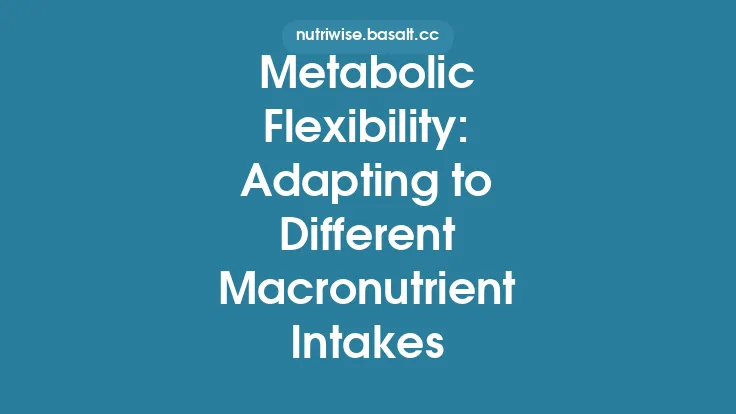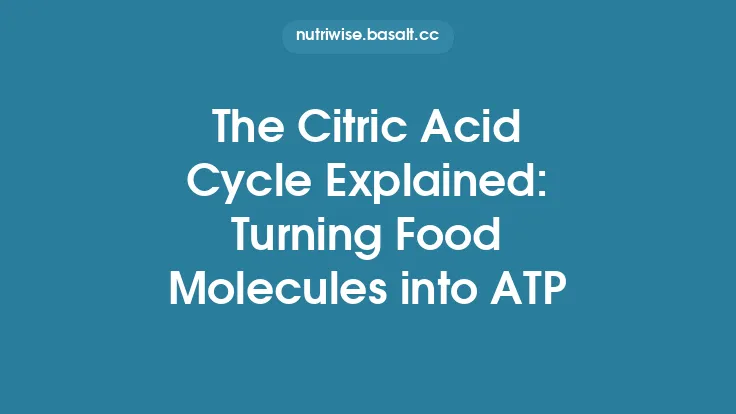The mitochondrion is often celebrated as the cell’s “powerhouse,” a compact organelle that transforms the chemical energy stored in the foods we eat into the universal energy currency, adenosine‑triphosphate (ATP). While the digestion of carbohydrates, fats, and proteins begins in the gastrointestinal tract and continues through a series of cytosolic pathways, the final and decisive step of energy extraction occurs inside the mitochondrial matrix and inner membrane. Here, electrons harvested from nutrient oxidation are funneled through a series of protein complexes, creating a proton gradient that drives the synthesis of ATP. Understanding how this conversion works provides a cornerstone for grasping broader metabolic physiology, the basis of many metabolic diseases, and the strategies cells use to adapt to varying energetic demands.
Mitochondrial Architecture and the Basis of Energy Conversion
Mitochondria possess a double‑membrane system that creates distinct compartments: the outer membrane, the intermembrane space, the inner membrane (highly folded into cristae), and the matrix. This architecture is essential because it establishes the physical separation required for the chemiosmotic mechanism. The inner membrane is impermeable to most ions and small molecules, forcing the cell to use specific transport proteins for substrates and products. The extensive surface area provided by the cristae maximizes the number of electron transport chain (ETC) complexes and ATP synthase enzymes that can be embedded, directly influencing the organelle’s capacity to generate ATP.
Import of Reducing Equivalents into the Matrix
Nutrients are first broken down into smaller metabolites that can be oxidized to release electrons. The three major classes of nutrients converge on a limited set of electron carriers:
- NADH – generated primarily from carbohydrate oxidation (via glycolysis and the citric acid cycle) and from the deamination of certain amino acids.
- FADH₂ – produced during the oxidation of fatty acids and some amino acids, as well as directly by the succinate dehydrogenase step of the citric acid cycle.
These carriers cannot cross the inner membrane freely. Instead, they donate their electrons to the ETC through dedicated shuttle systems:
- The malate‑aspartate shuttle efficiently transfers cytosolic NADH electrons into the matrix, preserving the high‑energy NADH.
- The glycerol‑3‑phosphate shuttle transfers electrons to ubiquinone (coenzyme Q) via flavoprotein dehydrogenases, albeit with a slight loss of energy because the electrons bypass complex I.
Fatty‑derived acetyl‑CoA enters the matrix directly after transport via the carnitine‑palmitoyl‑transferase system, where it is oxidized in the citric acid cycle, generating NADH and FADH₂ that feed the ETC.
The Electron Transport Chain: Stepwise Energy Extraction
The ETC consists of four large protein complexes (I–IV) and two mobile carriers (coenzyme Q and cytochrome c). Electrons travel from high‑energy donors to lower‑energy acceptors, releasing free energy at each step:
- Complex I (NADH:ubiquinone oxidoreductase) – Accepts electrons from NADH, pumping four protons from the matrix into the intermembrane space per NADH oxidized.
- Complex II (succinate dehydrogenase) – Receives electrons from FADH₂; unlike Complex I, it does not pump protons, making FADH₂ a slightly less efficient electron donor.
- Coenzyme Q (ubiquinone) – A lipid‑soluble carrier that shuttles electrons from Complexes I and II to Complex III.
- Complex III (cytochrome bc₁ complex) – Transfers electrons to cytochrome c while pumping another four protons per pair of electrons.
- Cytochrome c – A small, water‑soluble protein that ferries electrons to Complex IV.
- Complex IV (cytochrome c oxidase) – Reduces molecular oxygen to water, the final electron acceptor, and pumps two additional protons per electron pair.
Collectively, the movement of electrons through these complexes translocates approximately ten protons across the inner membrane for each NADH oxidized and six for each FADH₂ oxidized.
Proton Motive Force and Chemiosmotic Coupling
The translocation of protons creates an electrochemical gradient known as the proton motive force (PMF), composed of two components:
- ΔpH (chemical gradient) – A difference in proton concentration between the intermembrane space (acidic) and the matrix (alkaline).
- Δψ (electrical potential) – A voltage difference generated by the separation of positive charge (protons) from the negatively charged matrix.
According to Peter Mitchell’s chemiosmotic theory, the energy stored in the PMF can be harnessed to drive ATP synthesis. The magnitude of the PMF is typically around 180–200 mV, sufficient to power the rotary mechanism of ATP synthase.
ATP Synthase: The Molecular Rotary Engine
ATP synthase (Complex V) is a remarkable enzyme that couples proton flow back into the matrix with the phosphorylation of ADP to ATP. It consists of two functional domains:
- F₀ – An integral membrane channel that allows protons to pass through. The flow of protons causes rotation of a central stalk.
- F₁ – A peripheral catalytic domain where ADP and inorganic phosphate (Pi) bind. The rotational energy induces conformational changes in three catalytic β‑subunits, each cycling through “loose,” “tight,” and “open” states that correspond to substrate binding, ATP synthesis, and product release, respectively.
For each full 360° rotation, three ATP molecules are generated, and approximately three to four protons are required, depending on the organism and the exact stoichiometry of the c‑ring in the F₀ sector.
Mitochondrial Substrate Utilization: Carbohydrates, Lipids, and Amino Acids
Although the ETC itself does not discriminate among the origins of the electrons, the upstream pathways that feed NADH and FADH₂ differ in their regulation and efficiency:
- Carbohydrate oxidation – Provides a rapid supply of NADH via glycolysis and the citric acid cycle. Because each glucose molecule yields two NADH from glycolysis (via the malate‑aspartate shuttle) and six from the citric acid cycle, carbohydrate catabolism is highly efficient for ATP production.
- Fatty‑acid oxidation – Generates large amounts of acetyl‑CoA and reducing equivalents through β‑oxidation. Each round of β‑oxidation yields one NADH and one FADH₂, plus an acetyl‑CoA that enters the citric acid cycle. The high proportion of FADH₂ (which bypasses Complex I) makes fatty‑acid oxidation slightly less ATP‑dense per carbon, but the overall yield per gram of fat is greater because of the high energy content of fatty acids.
- Amino‑acid catabolism – Certain amino acids are deaminated and converted into citric‑acid‑cycle intermediates (e.g., α‑ketoglutarate, oxaloacetate, succinyl‑CoA). Their contribution to mitochondrial ATP production is modest under normal dietary conditions but becomes significant during prolonged fasting or high‑protein diets.
The mitochondrion thus acts as a hub where the oxidation of diverse nutrients converges into a common electron‑carrier pool, enabling flexible adaptation to dietary composition.
Regulatory Mechanisms Within the Organelle
Mitochondrial ATP production is tightly regulated to match cellular demand:
- Allosteric control of dehydrogenases – NAD⁺‑dependent enzymes such as isocitrate dehydrogenase and α‑ketoglutarate dehydrogenase are activated by ADP and inhibited by ATP and NADH, providing feedback based on the energy state.
- Calcium signaling – Increases in cytosolic Ca²⁺ (e.g., during muscle contraction) are taken up by mitochondria and stimulate several dehydrogenases, accelerating NADH production.
- ADP/ATP translocase (ANT) – Exchanges matrix ATP for cytosolic ADP, ensuring that ATP synthesis proceeds only when ADP is abundant.
- Respiratory control ratio (RCR) – The ratio of state 3 (ADP‑stimulated) to state 4 (resting) respiration reflects the tight coupling between electron flow and ATP synthesis; a high RCR indicates efficient coupling.
These mechanisms allow mitochondria to respond rapidly to changes in workload, substrate availability, and hormonal cues without relying on external signaling pathways that dominate cytosolic metabolism.
Mitochondrial Efficiency, Uncoupling, and Heat Production
Not all proton flow through the inner membrane is captured for ATP synthesis. Uncoupling proteins (UCPs) provide controlled pathways for protons to re‑enter the matrix without driving ATP synthase. This “leak” dissipates the PMF as heat, a process essential for thermogenesis in brown adipose tissue and for regulating reactive oxygen species (ROS) production.
The P/O ratio (phosphate/oxygen) quantifies the number of ATP molecules generated per atom of oxygen reduced. In mammals, the typical P/O ratio is ~2.5 for NADH and ~1.5 for FADH₂, reflecting the combined effects of proton pumping, ATP synthase stoichiometry, and any uncoupling.
Understanding the balance between tightly coupled respiration (maximizing ATP yield) and controlled uncoupling (producing heat or limiting ROS) is crucial for interpreting metabolic adaptations such as cold exposure, diet‑induced thermogenesis, and certain pathological states.
Reactive Oxygen Species: By‑product and Signaling Molecule
A small fraction of electrons escape the ETC and react with molecular oxygen to form superoxide (O₂⁻·). This primary ROS is rapidly converted to hydrogen peroxide (H₂O₂) by mitochondrial superoxide dismutase (SOD2). While excessive ROS can damage lipids, proteins, and DNA, low‑level ROS serve as signaling molecules that modulate:
- Hypoxic responses – Stabilization of HIF‑1α under low oxygen.
- Metabolic remodeling – Activation of transcription factors such as NRF2 that up‑regulate antioxidant defenses.
- Apoptosis – Release of cytochrome c from the intermembrane space, a key step in programmed cell death.
Mitochondria possess an array of antioxidant systems (glutathione peroxidase, peroxiredoxins, thioredoxin) that keep ROS within a physiological window, illustrating the organelle’s dual role as both energy generator and redox regulator.
Mitochondrial Biogenesis and Turnover in Metabolic Health
The number and functional quality of mitochondria are dynamic, governed by two complementary processes:
- Biogenesis – Coordinated transcriptional activation of nuclear‑encoded mitochondrial genes (via PGC‑1α, NRF1/2, and TFAM) and mitochondrial DNA replication. Endurance exercise, caloric restriction, and certain nutraceuticals (e.g., resveratrol) stimulate this pathway, enhancing oxidative capacity.
- Mitophagy – Selective autophagic removal of damaged mitochondria, mediated by the PINK1‑Parkin axis. Efficient mitophagy prevents accumulation of dysfunctional organelles that would otherwise leak electrons and generate excess ROS.
A balance between biogenesis and mitophagy determines mitochondrial quality control, influencing whole‑body insulin sensitivity, endurance performance, and susceptibility to age‑related metabolic decline.
Clinical Implications of Mitochondrial Dysfunction
When the mitochondrial power plant falters, the consequences reverberate throughout the organism:
- Metabolic diseases – Impaired oxidative phosphorylation contributes to insulin resistance, non‑alcoholic fatty liver disease, and obesity by limiting fatty‑acid oxidation and promoting ectopic lipid accumulation.
- Neurodegeneration – Neurons are highly dependent on oxidative metabolism; deficits in Complex I activity are linked to Parkinson’s disease, while mitochondrial DNA mutations underlie certain forms of Alzheimer’s disease.
- Cardiomyopathies – The heart’s relentless demand for ATP makes it vulnerable to defects in the ETC; mutations in mitochondrial genes can cause hypertrophic or dilated cardiomyopathy.
- Mitochondrial myopathies – Genetic lesions in mitochondrial DNA or nuclear‑encoded mitochondrial proteins manifest as exercise intolerance, muscle weakness, and lactic acidosis.
Therapeutic strategies aimed at enhancing mitochondrial function—such as exercise prescriptions, dietary interventions (e.g., ketogenic or high‑fat low‑carb diets that shift substrate utilization), pharmacologic uncouplers, or agents that boost NAD⁺ levels—are under active investigation for their potential to ameliorate these conditions.
In sum, the mitochondrion translates the chemical energy of digested nutrients into a usable form through a finely tuned series of redox reactions, proton translocation, and rotary catalysis. Its ability to integrate carbohydrates, fats, and proteins into a common electron‑carrier pool, regulate energy output in response to cellular demand, and maintain redox balance underscores its central role in metabolism. A deeper appreciation of mitochondrial power generation not only enriches our understanding of basic physiology but also informs the development of interventions targeting a wide spectrum of metabolic and age‑related diseases.





